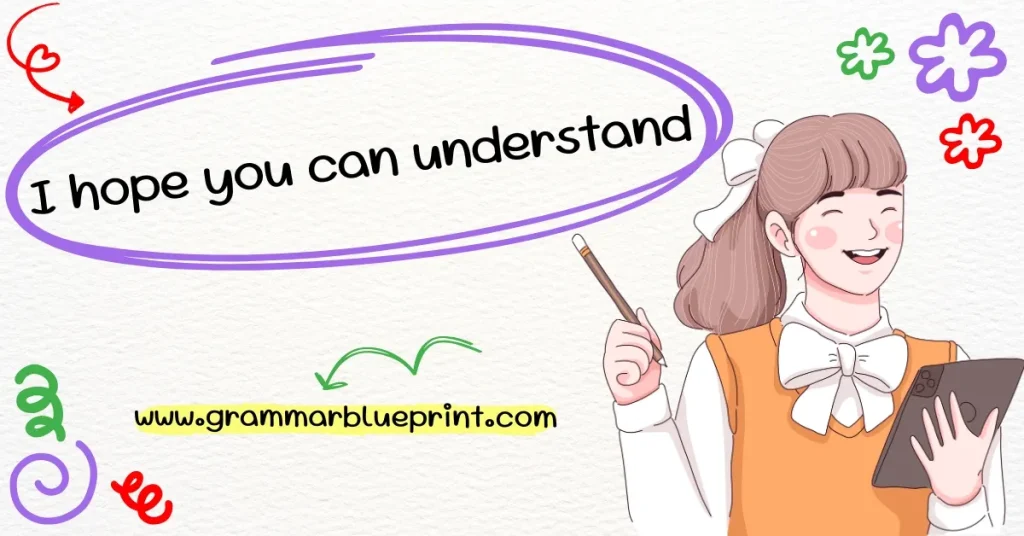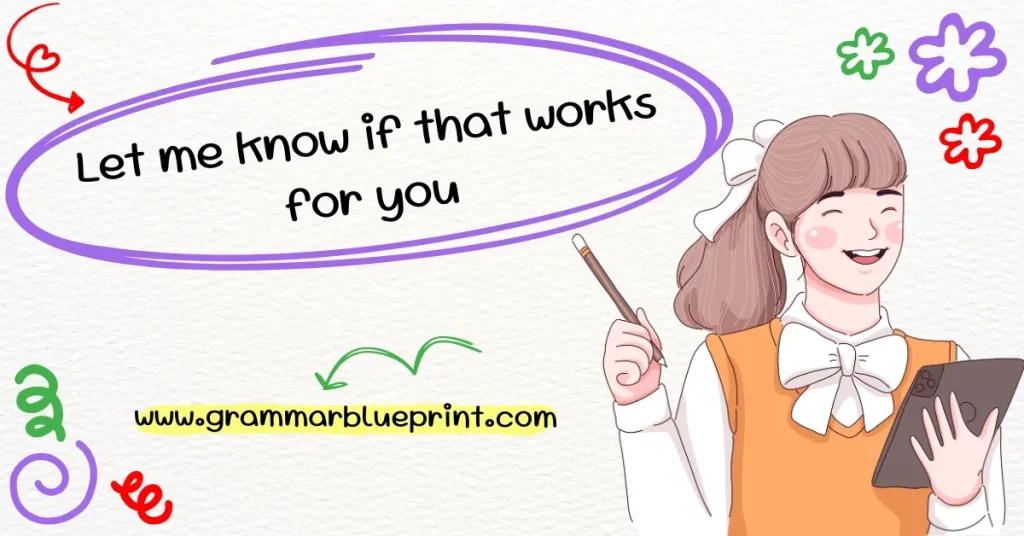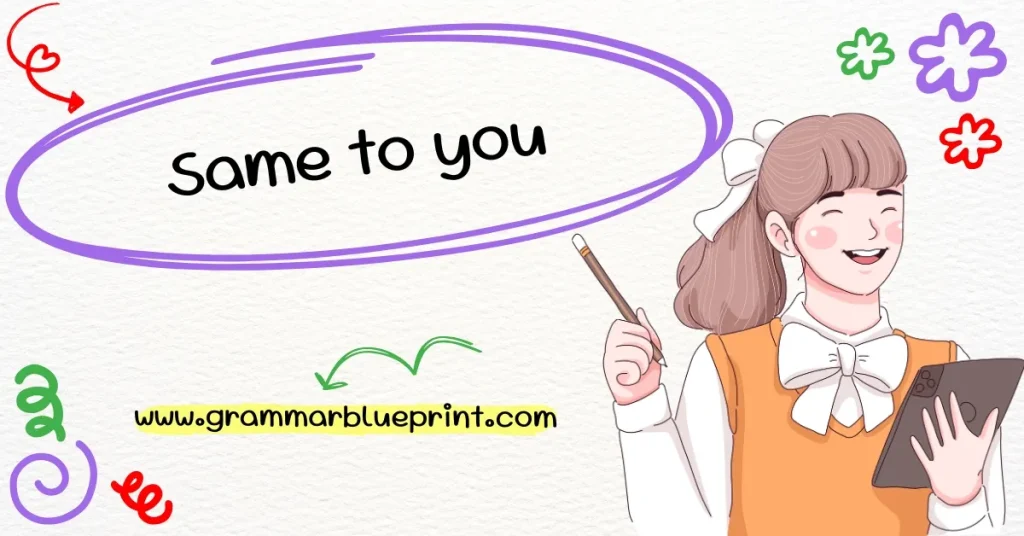In everyday communication, expressing that you hope someone understands what you’re saying is an essential skill. The phrase “I hope you can understand” is often used in both formal and informal contexts to convey empathy, clarity, and a request for understanding. It helps ensure that your message is clear and that the other person is on the same page.
What is the Meaning of “I Hope You Can Understand”?
“I hope you can understand” is a polite phrase used to express a desire that the listener or reader comprehends the message being communicated. It often implies that the message may be complex, sensitive, or requires some level of empathy or consideration.
- Contexts in which it is used:
This phrase is commonly used when explaining something difficult, asking for patience, or when you are worried that the listener may find the situation unclear or difficult to grasp.
- Differences from similar phrases:
Similar phrases like “I hope you understand” are often used interchangeably but can differ slightly in tone. “I hope you understand” tends to sound more direct, while “I hope you can understand” adds a softer, more empathetic touch. Both are used to check comprehension but with subtle differences in tone and intention.
When to Use “I Hope You Can Understand”
The phrase “I hope you can understand” is particularly useful in several scenarios:
- Situations in which the phrase is commonly used:
It’s often used when conveying difficult news, making a request, or discussing a complex topic where the listener may need extra effort to follow along.
- Formal vs. informal usage:
This phrase can be used in both formal and informal contexts. In a business email or formal communication, it shows respect and consideration for the recipient’s understanding. In casual conversation, it softens the tone of your message, making it more personal and less abrupt.
- Examples of appropriate contexts:
- Business email: “I hope you can understand the delays in the project timeline due to unforeseen circumstances.”
- Personal conversation: “I hope you can understand why I need some space right now.”
- Business email: “I hope you can understand the delays in the project timeline due to unforeseen circumstances.”
How to Use “I Hope You Can Understand” in Sentences
Here are a few examples of how to incorporate “I hope you can understand” into different sentences:
Simple Sentence Examples
- “I hope you can understand my decision to leave the company.”
- This sentence uses the phrase to soften the reason behind a potentially difficult decision.
- This sentence uses the phrase to soften the reason behind a potentially difficult decision.
- “I hope you can understand how hard this is for me.”
- Here, it expresses the emotional weight behind the situation.
- Here, it expresses the emotional weight behind the situation.
Complex Sentence Examples
- “I hope you can understand that while I value your opinion, I need to make this decision on my own.”
- This sentence shows the speaker’s need for autonomy while also showing respect for the listener’s thoughts.
- This sentence shows the speaker’s need for autonomy while also showing respect for the listener’s thoughts.
- “Given the circumstances, I hope you can understand that I need more time to complete the task.”
- A request framed with empathy, allowing the listener to recognize the difficulties involved.
- A request framed with empathy, allowing the listener to recognize the difficulties involved.
Common Variations
- “I hope you understand my situation.”
- “I hope you can follow what I’m saying.”
- “I trust you understand what I mean.”
Better Alternatives to Say “I Hope You Can Understand”
While “I hope you can understand” is useful, there are several alternative expressions that can convey the same idea in a more varied or suitable way depending on the context. Let’s explore some of the most common alternatives.
1. I trust you understand
- Meaning: Implies confidence that the other person will grasp the message.
- Best Use: Often used in formal contexts like business communications or emails.
- Tone: Polite and formal.
2. I hope that makes sense
- Meaning: This phrase invites the listener to confirm if they have understood.
- Best Use: Perfect for situations where clarity is important, such as explaining instructions or concepts.
- Tone: Casual and approachable.
3. I hope you’re able to follow
- Meaning: Used when providing instructions or an explanation that might be complex.
- Best Use: Great for teaching or explaining difficult concepts.
- Tone: Friendly and reassuring.
4. I trust this is clear
- Meaning: Used when you expect the listener to have understood your message.
- Best Use: In emails or official statements where you want to maintain professionalism.
- Tone: Confident and formal.
5. I hope you get it
- Meaning: More informal and can be used when you are unsure if your explanation was understood.
- Best Use: In casual conversations or informal contexts.
- Tone: Relaxed and conversational.
6. I hope you’re with me
- Meaning: Used to check if the listener is following along during a conversation or explanation.
- Best Use: Great in informal or peer-to-peer discussions.
- Tone: Informal and engaging.
7. I trust this explanation helps
- Meaning: Indicates you’ve provided an explanation and trust the listener can now understand.
- Best Use: Ideal for professional emails or after giving a detailed explanation.
- Tone: Formal and confident.
8. I hope this clarifies things
- Meaning: Used to ensure that any confusion has been cleared up.
- Best Use: After providing an explanation to resolve misunderstandings.
- Tone: Polite and neutral.
9. I trust you can grasp that
- Meaning: Confidently asserts that the listener will be able to understand the information.
- Best Use: In discussions requiring a deeper understanding.
- Tone: Formal but reassuring.
10. I hope it’s clear to you
- Meaning: Used to check if the listener fully understands the topic.
- Best Use: In academic or work settings when providing information that requires comprehension.
- Tone: Formal and respectful.
11. I hope this is understandable
- Meaning: To ask if the message or concept is clear.
- Best Use: Can be used in both casual and formal contexts.
- Tone: Gentle and neutral.
12. I trust this makes sense to you
- Meaning: Assures that the listener should understand the explanation.
- Best Use: In professional communication where you expect understanding.
- Tone: Polite and formal.
13. I hope you’re able to comprehend
- Meaning: Used to express hope that the listener can comprehend the given information.
- Best Use: In technical or academic contexts.
- Tone: Formal and slightly more advanced.
14. I trust you see where I’m coming from
- Meaning: Implies you’ve explained your viewpoint, and you hope the other person understands.
- Best Use: In discussions that involve perspectives or personal opinions.
- Tone: Casual but thoughtful.
15. I hope you’re able to follow along
- Meaning: Used when explaining something step-by-step.
- Best Use: In tutorial-style explanations or instructions.
- Tone: Friendly and patient.
16. I trust this is easy to understand
- Meaning: Assures the listener that the explanation should be simple to grasp.
- Best Use: When the message is simple, but you want to ensure clarity.
- Tone: Reassuring and neutral.
17. I hope this isn’t too confusing
- Meaning: Used to check if the message is clear, especially if it’s complex.
- Best Use: After delivering a lengthy or complicated explanation.
- Tone: Friendly and empathetic.
18. I hope that explanation is clear
- Meaning: Used to confirm if the listener understood the explanation.
- Best Use: After a detailed explanation.
- Tone: Neutral and professional.
19. I trust you can make sense of this
- Meaning: Shows confidence that the explanation is comprehensible.
- Best Use: In formal or professional settings.
- Tone: Polite and confident.
20. I hope it’s easy to grasp
- Meaning: Used to confirm if the information is clear and simple.
- Best Use: After presenting a simple explanation.
- Tone: Casual and approachable.
21. I hope you’re able to absorb this
- Meaning: Used when the information is dense or detailed, and you want to confirm understanding.
- Best Use: In educational settings.
- Tone: Neutral but considerate.
22. I trust you can take this in
- Meaning: Implies the listener should be able to understand the message, even if it’s complex.
- Best Use: In situations requiring focus and attention.
- Tone: Professional and respectful.
23. I hope this resonates with you
- Meaning: Used when hoping the listener feels connected to the message.
- Best Use: In motivational or personal conversations.
- Tone: Empathetic and supportive.
24. I trust this isn’t hard to understand
- Meaning: Used to confirm if the explanation was simple.
- Best Use: In professional or clear communication.
- Tone: Neutral and confident.
25. I hope this clarifies my point
- Meaning: Used to confirm if the listener fully understands your perspective.
- Best Use: After making a complicated point or argument.
- Tone: Polite and formal.
26. I hope you find this easy to understand
- Meaning: Ensures the explanation is clear and comprehensible.
- Best Use: When presenting new information.
- Tone: Friendly and accessible.
27. I trust this isn’t unclear
- Meaning: Used to make sure the message is not ambiguous.
- Best Use: In formal communication when you want to ensure understanding.
- Tone: Formal and confident.
28. I hope you are able to grasp this
- Meaning: Used to check comprehension after delivering a complex idea.
- Best Use: When explaining something technical or detailed.
- Tone: Formal and respectful.
29. I hope you can make sense of it
- Meaning: Similar to other phrases, this checks if the information is understandable.
- Best Use: When the topic is complex but you want to ensure clarity.
- Tone: Neutral but clear.
30. I trust you’re following me
- Meaning: Used during a step-by-step explanation to make sure the listener is keeping up.
- Best Use: In conversations where you give instructions or directions.
- Tone: Friendly and supportive.
Benefits of Using “I Hope You Can Understand” in Communication
- Shows empathy and consideration: It softens your message, indicating that you care about the other person’s ability to follow along.
- Helps soften a request or statement: By using this phrase, you make your request sound less demanding and more considerate.
- Promotes clear communication in sensitive topics: In conversations that might be uncomfortable or delicate, it adds a layer of understanding and compassion.
Common Mistakes to Avoid When Using “I Hope You Can Understand”
- Overuse of the phrase: Using it too often can make your communication sound hesitant or uncertain. Use it strategically.
- Using it inappropriately in formal settings: While the phrase is useful, it may be too informal for some professional environments. Use more formal alternatives when needed.
- Confusing it with other phrases that express similar meanings: Be mindful of when to use this phrase and when other expressions might be more fitting for the context.
Tips for Non-Native English Speakers Using “I Hope You Can Understand”
- Practice with different sentence structures: Experiment with different variations to find what works best in each context.
- Avoid direct translation from native language: This phrase may have different nuances in other languages, so it’s important to learn its exact usage in English.
- Use the phrase appropriately based on context: Whether formal or informal, ensure that you’re using the phrase in a way that feels natural and polite for the situation.
Cultural Differences in Using “I Hope You Can Understand”
- How the phrase might be perceived in different cultures: In some cultures, it may be viewed as overly polite or uncertain. Understanding the local communication style is important.
- Potential misunderstandings and how to avoid them: Be cautious of using this phrase when it might imply a lack of confidence.
- Using the phrase with sensitivity in cross-cultural communication: Always ensure that your communication aligns with cultural expectations and that you are sensitive to how others might interpret your words.



